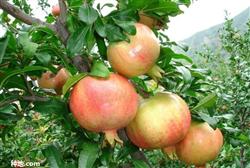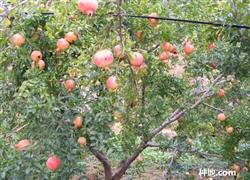How to cultivate pomegranate bonsai

How to cultivate pomegranate bonsai? To guide the cultivation of pomegranate bonsai can be as follows: first, the management of the pile stage. Bonsai is made of small pomegranate trees with short plant shape, small leaves and small flowers and fruits, such as fire pomegranate, four seasons pomegranate, agate pomegranate and so on. Pomegranate can be propagated by sowing and cutting. The saplings obtained by the above two methods need to be planted for more than 3 years before they can be cut off and accumulate branches to cultivate small and medium-sized bonsai. If you want to make large bonsai, you can dig tree stumps in the mountains or buy old potted pomegranates in the flower and tree market. Second, the management of the branch storage stage. According to the shape of the pomegranate tree, truncate the trunk at the appropriate height and truncate the main branch. Pomegranate bonsai can be made into straight dry, oblique dry, curved dry and other tree shapes, some ancient pile pomegranate bonsai, the trunk is composed of two pieces of bark with xylem, and the branches at the top of each bark bear fruit. Pomegranate trees have a certain degree of cold resistance, with a little protection in the leeward direction, they can survive the winter outdoors in North China. In order to make the trees grow fast, it is better to plant them on the ground. Pomegranate trees like fertilizer. In addition to applying basic fertilizer when planting, pomegranate trees apply mature and thin organic fertilizer once every 15 days during the prosperous growth period of spring and summer. The pomegranate tree grows faster, and when the thickness of the branch reaches about 70% of the ideal thickness, the branch is cut short to promote the growth and development of lateral branches. Third, the management of the forming stage. After several years of branch cultivation and pruning, when the pomegranate tree basically meets the design composition standard, the pomegranate stump is planted in an ornamental pot of suitable size and style in early spring, the straight dry type and oblique dry type can be planted in an oval medium depth or shallower pot, and the curved dry type can be planted in a square medium depth pot. At this stage of cultivation, it is still necessary to apply more fertilizer to promote tree growth and better shape. On the other hand, we should also take into account the need for appreciation. Fourth, the maintenance after forming. Pomegranate bonsai after several years of cultivation, pruning and shaping after maintenance, on the basis of maintenance, to achieve the purpose of viewing flowers in spring and fruit in autumn (pomegranate does not bear fruit), we should pay attention to the following points: 1, shaping. The pomegranate tree has strong sprouting ability and grows new branches several times in a year. In general, strong new branches growing in spring can form fruiting mother branches. in the following spring, the terminal buds or axillary buds from these branches produce short new branches that often blossom, among which the flowers with terminal buds are the most likely to set fruit. Buds that grow in summer and autumn should be cut off in time. Pomegranate bonsai shaping is often carried out before sprouting in spring, cutting off overgrown, over-dense and weak branches, and pay attention to preserving those robust fruiting mother branches. 2. Fertilization. Pomegranate trees like fertilizer more than ordinary flowers and trees, and when turning over the basin, put more fermented hoof or cake fertilizer at the bottom of the basin. Fertilizers with more phosphorus should be applied during the peak growth period in spring and summer. 3. Lighting and watering. The period from late April to early June is the budding period of pomegranate. There should be sufficient light and less watering to make the basin soil dry. When the new leaves on the branches wilt slightly, put the pomegranate tree in the shade for 30 minutes, and then pour enough water into the basin. Repeat this several times, and buds will appear in about 20 days. 4. Thinning fruit. After the fruit is in prison, you should cut off too many fruits that are not needed in shape, and leave 3-5 fruits in a medium-sized pomegranate bonsai. Fruit distribution should be scattered, sparse and dense, not equidistant. If there are too many fruits, in addition to being disorganized, it will also affect the results of next year. Click to get more pomegranate planting techniques click to get more fruit planting techniques
- Prev

How to fertilize pomegranate trees without pollution
How does pomegranate tree fertilize without pollution? Please give an introduction to guide pomegranate tree pollution-free fertilization can refer to the following methods: first, the key to whether the fertilization period is scientific and reasonable is to grasp several critical periods of pomegranate tree growth and development. Pomegranate tree fertilization is divided into base fertilizer and topdressing. Ji Fei Yi.
- Next

What should pomegranate trees pay attention to?
What should pomegranate trees pay attention to? Please introduce the cultivation place pomegranate likes plenty of sunlight, when there is not enough sunlight, not only the plant is weak and overgrown, but also it blossoms poorly, but it is resistant to drought and cold. Therefore, when choosing a cultivation site, you should pay attention to choosing a place with full sunshine. It should be noted that pomegranate is not resistant to stagnant water.
Related
- Moge, come on! The staff of the peasant association in the producing area of cantaloupe were frightened when the crowd gathered.
- Causes and Solutions of low Fruit setting rate of Apple
- Symptoms and control measures of passion fruit virus disease
- Fruit growing lesson: how do apple orchards keep high yields?
- Can you build orchards in the mountains? What are the pros and cons?
- How to manage the coloring period of Crisson grape?
- This paper introduces the processing technology of two kinds of fig products.
- How much is a month for retired teachers in rural areas by 2020?
- How can strawberry planting increase sugar content? We should pay attention to management in many aspects.
- What are the cultivation techniques on how to improve the yield of golden fruit?

